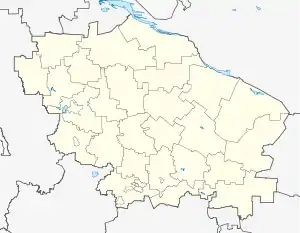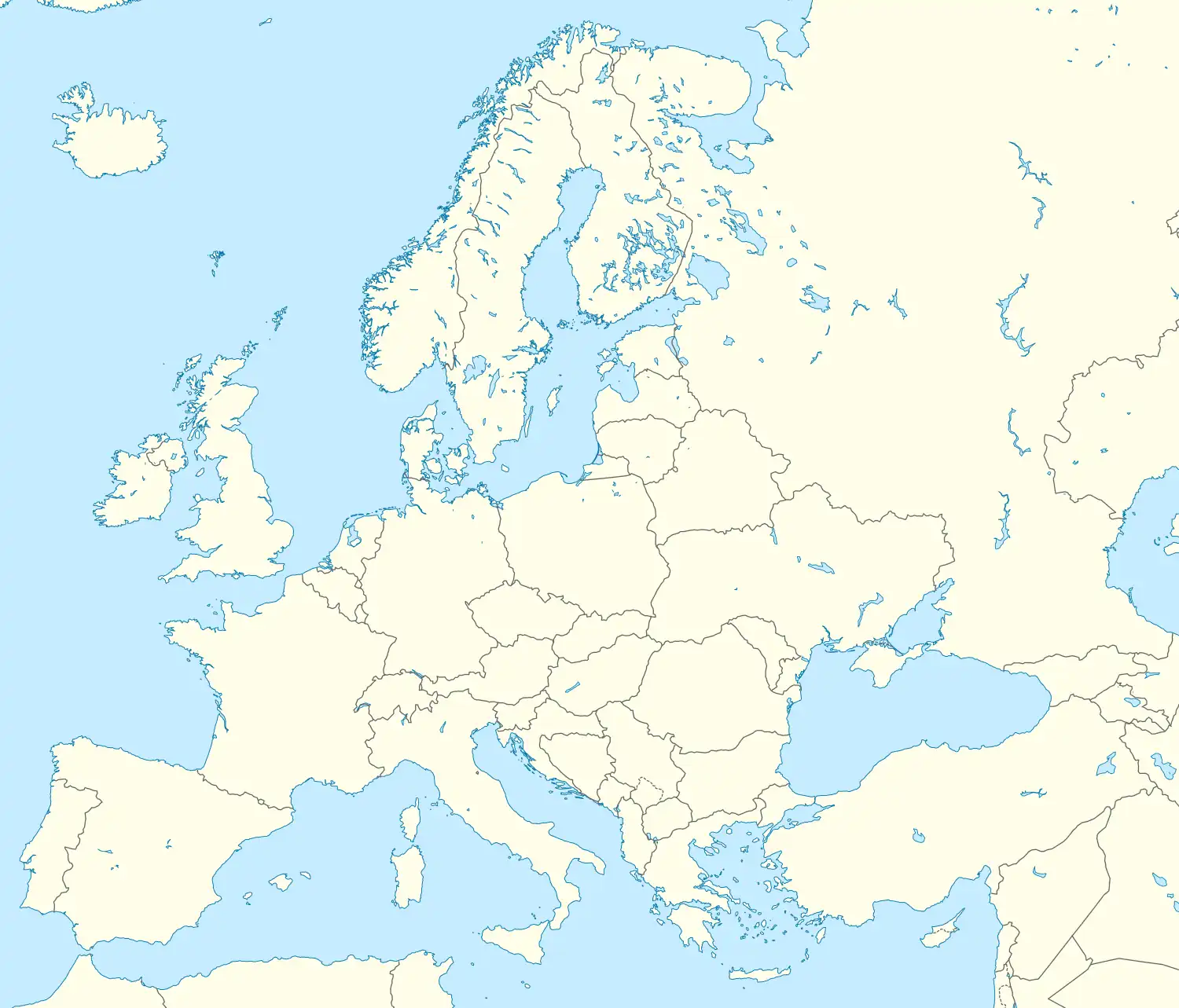Orbelyanovka (Russian: Орбельяновка, German: Orbeljanowka) is a rural locality (a selo) in Stavropol Krai, in southern Russia.
Orbelyanovka
Орбельяновка | |
|---|---|
Location of Orbelyanovka | |
 Orbelyanovka Location of Orbelyanovka .svg.png.webp) Orbelyanovka Orbelyanovka (European Russia)  Orbelyanovka Orbelyanovka (Europe) | |
| Coordinates: 44°13′55″N 42°53′11″E / 44.23194°N 42.88639°E | |
| Country | Russia |
| Federal subject | Stavropol Krai |
| Time zone | UTC+3 (MSK |
| Postal code(s)[2] | 357224 |
| OKTMO ID | 07721000271 |
Location
Orbelyanovka is located in the North Caucasus, around 20 km west of Mineralnye Vody, and around 25 km northwest of the health resort city Pyatigorsk. The village lies on the right bank of Kuma River at 400 m above the sea level, to the north of the so-called Camel Mountain with two distinctive humps.
History
Orbelyanovka was founded in 1868 by German Christians affiliated with the Temple Society.[3][4][5][6]
The village owns its name to the former landowner, the Georgian Prince Orbeliani. In the autumn of 1866, Johannes Dreher, Abram Dück and Friedrich Tietz from the Molotschna came to the Caucasus in search of a suitable place for settlement. In the valley of the river Kuma they found an uninhabited piece of land of about 10,000 desyatinas belonging to Orbeliani.
In 1867, the representatives of several German colonies travelled to Tiflis, then part of the Russian Empire, to visit the Price Orbeliani: brothers Fickel and Härter from Bessarabia, Abram Dück, Johann Schmidt, Johannes Lange from the Molotschna, Johann Gutwin and Paul Tietz from Igren by Ekaterinoslav. The Prince allowed them to rent his land by the river Kuma for 30 years, at 25 kopecks per desyatina. The colonies Tempelhof and Orbelyanovka were founded on this land in 1868. About 30 families who came from Bessarabia to settle in Orbelyanovka originally stemmed from Württemberg.
When the rental agreement had expired, the residents of both colonies moved about 200 km to the east, on the land of about 4,500 desyatinas given by the Crown. There the former inhabitants of Orbelyanovka founded the village Romanovka and the former inhabitants of Tempelhof - the village Olgino.
In 1942, during the World War II, Orbelyanovka was captured by German troops and then retaken by the Soviet army at the beginning of 1943.[7]
Notable residents
- Philipp Dreher - teacher and one of the founders of the village
- Ludmila Sergeeva - painter
Notes
- ↑ "Об исчислении времени". Официальный интернет-портал правовой информации (in Russian). 3 June 2011. Retrieved 19 January 2019.
- ↑ Почта России. Информационно-вычислительный центр ОАСУ РПО. (Russian Post). Поиск объектов почтовой связи (Postal Objects Search) (in Russian)
- ↑ Tempelgesellschaft 2001, p. 46: "Auf dem vom Fürsten Orbeljani gepachteten Land wurden 1868 die Beiden Kolonien „Tempelhof“ und „Orbejanowka“ gegründet."
- ↑ Tempelgesellschaft 2001, p. 57: "In den Jahren 1867 und 1868 ließ sich unsere Gesellschaft auf diesem Pachtgut nieder und gründete auf dieselben zwei Kolonien: die Molotschnaer und die Jekaterinoslawer - etwa 20 Familien stark - „Tempelhof“ am linken Ufer der Kuma, die Bessarabier mit den Württembergern - etwa 30 Familien stark - „Orbeljanowka“ am rechten Ufer."
- ↑ Lange 2013, p. 199: "...Die Kolonien Tempelhof und Orbeljanowka waren 1868 durch meine Vorfahren gegründet worden".
- ↑ Tamcke & Heinz 2005, p. 207: "In Absprache mit den „Jerusalemsfreunden“ aus Gnadenfeld legten sie 1868 auf dem Land des Fürsten Orbeljani die Kolonie Orbeljanowka am rechten Ufer des Kuma, nahe dem Kamelsberg an."
- ↑ Kingston Gleaner 1943, p. 1: "In between the straightened front the Russians were reported seizing the little towns of Kalaborka, Orbelianovka and Pobegailovskoe in the heart of some of the most intensively farmed land in the Caucasus. Battle front accounts said tanks led the Russian advance breaking Nazi counter attacks along highways and rail lines of Kuma river valley near Kumagorsky."
References
- Damals am Kaukasus. Ein Erzählbuch über Entstehung, Blütezeit und Untergangs der deutschen Tempelsiedlungen im Nordkaukasus-Gebiet (in German). Stuttgart, Germany: Tempelgesellschaft in Deutschland. 2001.
- Lange, Walter (2013). Deutsche Siedlungen im Nordkaukasus. Historiker über die Rolle der Deutschen in der Geschichte Russlands (in German). Lichtzeichen Verlag. ISBN 978-3-86954-087-0.
- Tamcke, Martin; Heinz, Andreas (2005). Die Suryoye und ihre Umwelt: 4. Deutsches Syrologen-Symposium in Trier 2004 (in German). Münster, Germany: LIT Verlag. ISBN 3-8258-8912-2.
- "Red War Bulletin Recounts Sharp Advance". Kingston Gleaner. Kingston. 15 January 1943.